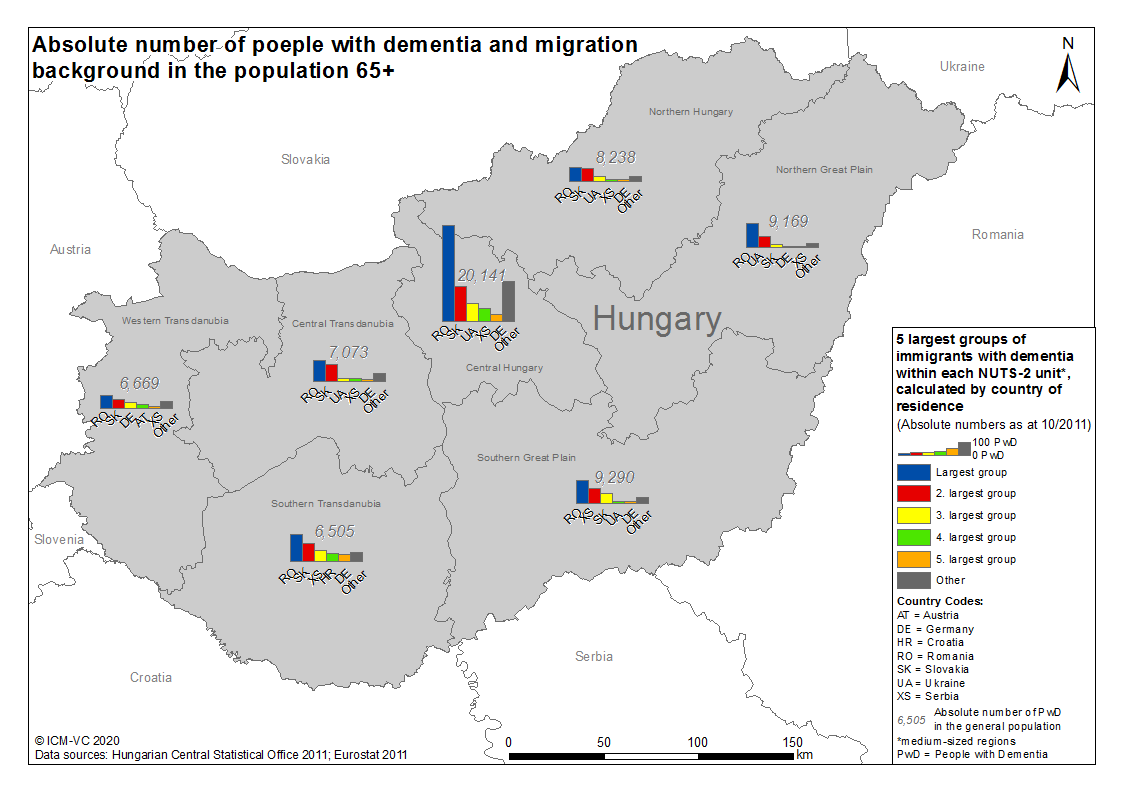EU-Atlas: Dementia & Migration
| Largest group | 2. largest group | 3. largest group | 4. largest group | 5. largest group | |
| Absolute numbers | |||||
| PwMD per 100,000 inhabitants 65+ |
| Absolute numbers | PwMD per 100,000 inhabitants 65+ | |
| Largest group | ||
| 2. largest group | ||
| 3. largest group | ||
| 4. largest group | ||
| 5. largest group |
| Prevalence per 100,000 inhabitants 65+*, calculated by country of residence | |||
|---|---|---|---|
| high > PwMD |
minor > - PwMD |
||
| increased > - PwMD |
low ≤ PwMD | ||
| medium > - PwMD |
|||
| PwMD = People with a Migration background with Dementia *Bulgarien, Litauen, Malta, Polen in der Bevölkerung 60+ |
|||
| Absolute number of PwMD 65+ | |
| PwMD per 100,000 inhabitants 65+ |
Hungary
In the last centuries, Hungary was characterised by waves of emigration as well as immigration. Reasons for emigration and immigration were the two world wars, the collapse of the communist system (1989/1990), or the EU accession in 2004. In the mid/late 1990s, Hungary developed from a sending country to a destination country for migrants. Between 2013 and 2015, there was a wave of extensive transit migration from Africa and the Middle East1. Currently, the immigration of labour migrants from neighbouring countries (especially from Ukraine) represents the central characteristic of migration. Between 1990 and 2019, the migrant population (born abroad) increased from 347,500 to 512,000, and the proportion of migrants in the total population grew from 3.3 to 5.3%2. By now, Hungary is a country of sending, transit, and destination of migrants3.
There are 99,700 people with a migration background aged 65 or older. Of those, approx. 4,000 are estimated to exhibit some form of dementia. Calculations show the most affected migrant groups presumably originate from Romania (approx. 1,700), Slovakia (approx. 800), Serbia (approx. 400), Ukraine (approx. 300), and Germany (approx. 200)4.
‘Living with Dementia: National Dementia Strategy’ from 2021 is a 23-page document that addresses topics such as definition, diagnosis, and causes of dementia, or service development. However, the topic of migration does not play a significant role5. The ‘Professional Protocol for Diagnosis, Treatment, and Care of Dementia’ expired on 31 December 2013 and have not been renewed since then. This document is 46 pages long and contains chapters on the diagnosis of dementia and on therapy. The topic of migration is not addressed6.
References
- Kallius A: The East-South Axis: Legitimizing the “Hungarian Solution to Migration”. Revue européenne des migrations internationales 2017, 33.
- International Organisation for Migration: International migrant stock as a percentage of the total population at mid-year 2019: Hungary. 2019.
- Juhász J: Hungary: Transit Country Between East and West. [https://www.migrationpolicy.org/article/hungary-transit-country-between-east-and-west]. (2003). Accessed 07 May 2020.
- Hungarian Central Statistical Office: Census 2011; 2011.
- Society of the Relatives of the People: Living with Dementia: National Dementia Strategy.
- Professional College of Psychiatry: Az Egészségügyi Minisztérium szakmai protokoll A demencia kórismézése, kezelése és gondozása. In. Edited by Ministry of Health Hungary; 2008.



![[Translate to Englisch:] Logo RBS [Translate to Englisch:] Logo RBS](/fileadmin/_processed_/9/7/csm_RBS_Logo_RGB_0e245a98a4.jpeg)